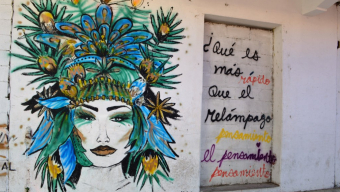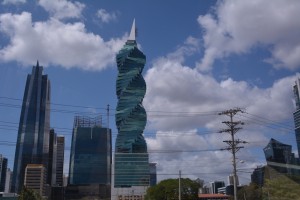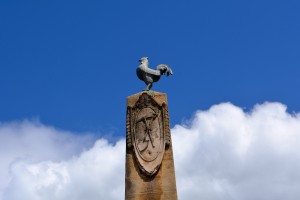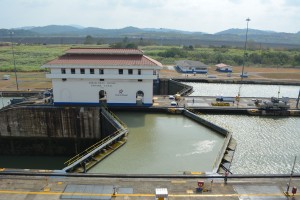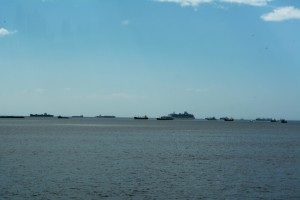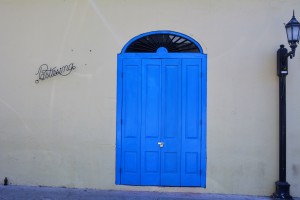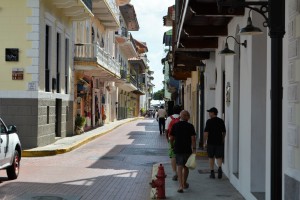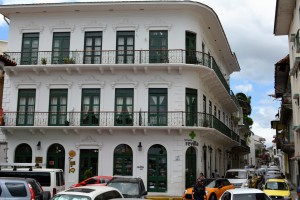Editor’s Note: During this difficult time dealing with the Coronavirus outbreak, leaving golf writers nothing to write about, we decided to revisit some of the places we have gone over the years. Today, we finish our series on Panama.
(Third of three parts)
PANAMA CITY, Panama – Let’s go back about three million years, or as anthropologists call the pre-Keith Richards Period, when the earth was shaping the mighty continents of what would become North and South America.
It was around this time, give or take a few millennium, that a land mass “rose from the sea” to finally provide a bridge to connect the well-developed two continents as well as divide the ‘North’ and ‘South’ seas. That land mass was the missing link that allowed the free flow of the animals, the spread of the vegetation and, eventually, the movement of people anywhere around the Western Hemisphere.
The late-arriving land bridge essentially set the tone for the Isthmus of Panama. The country has played catch-up to its mid-globe neighbors ever since. Even after discovering the New World, it took Christopher Columbus another decade to get down there. Then another decade later, Spanish conquistador Vasco Nunez de Balboa led an grueling expedition across the isthmus to discover the Pacific Ocean. Through the native Cueva people living on the coast then might not have been so awestruck by his ‘discovery.’
Spanish explorers used that narrow pathway – about 50 miles – from one ocean to the other to haul out treasures and natural resources back to the homeland. Balboa ultimately would be beheaded by a jealous rival but at least the country recognizes him with statues and the national beer.
Panama was colonized and exploited for the next 300 years under Spanish rule. After breaking from Spain in 1821, the country formed various governing alliances with neighbors Peru, Venezuela and Colombia. It was still not its own country but one ruled remotely with people from all over passing through it in every direction. The country finally broke away from Colombia in 1903 to become an independent sovereign nation unto itself.
Just one year later, the country began a century of close association with the United States as American ingenuity took over the task (from the French) of connecting the Atlantic with the Pacific through a series of canals and locks. With tedious grunt work and inspiring technology, the Panama Canal opened on Aug. 15, 1914.
That changed everything. This ancient land that started as a east-west land bridge for the Americas now introduced an breath-taking, time-saving north-south water path that dramatically altered world commerce.
That’s the truncated history and you might notice no mention of golf yet. That also has been a late-arriving pursuit. Its neighbors, Costa Rica, Mexico, the Caribbean islands and even pre-Castro Cuba, built a multitude of courses over the past century to attract the tourists. Panama did not develop its first course until 1922 and that was built and used primarily by American Canal workers. It wasn’t until the 1977 before a second one was built – replacing the first – followed by several more recently.
“In 15 years we went from four to 13 or 14 golf courses,” said Leo Gutierrez, a former competitive golfer who lives on the Tom Fazio-designed Coronado course 70 miles west of Panama City.
Finally, Panama has the missing links.
Panama Golf Association opened up the country recently for a handful of golf writers and tour operators to view the latest country has to offer. There currently are 13 (18-hole) courses, mostly on the Pacific side. We visited nine of them and played five. It’s quite a good start with two Jack Nicklaus-designed layouts, a Fazio, several connected to high-quality resorts, one in a rain forest and the promise of more to come. Panama is becoming fluent in Titleist.
Today we begin the first of a two-part series on Panama golf. The first one – Canal holes – deals with courses around Panama City, where the Canal cuts through. The second part Saturday – Beachy Beauties – deals with courses down the west coast, alongside the Pacific beaches.
Overall, Panama is not yet a true golf destination along the same parallel as Hawaii or Mexico or some of the Caribbean islands. But it is a wonderful tourist destination, as good as some of those others spots, where you also can enjoy a good round of golf on a quality course.
But first, here’s a random perspective on Panama, its past, its present, its quirks and its uniqueness. We begin with what Panama is best known, the Canal:
The Canal:
-
-
The French actually had the plan and motivation to build the ‘path to connect the seas.” They just didn’t have the technology or the persistence. Under Ferdinand de Lesseps, the developer of the Suez Canal, the French set up camp in Panama in 1881. Malaria, yellow fever and lack of funds ended the effort after 15 years. It is estimated that more than 20,000 lives were lost during the failed effort. What that did was advance medical treatment of those diseases to allow the Americans to take over the project in 1904. With better technology, better medicine and a better plan, the Canal was finished in 1914, 401 years after Balboa crossed the country to the Pacific.
- The U.S. paid the French government $40 million for its effort and remaining equipment.
-
For those who think that maybe you just plow open a hole on each side of the country and let the tide take the ships through, that won’t work. The tides run on a six-hour cycle so ships would get stuck and operations would be too slow and deliberate. There’s also the need to completely separate the oceans because of different fish, different ecosystems and to protect Gatun Lake in between.
- For those who think that it wasn’t worth the massive effort, think again. If a ship captain decides to take the journey around the extremely turbulent Cape Horn, below South America and come up the other side, it takes 22 days and costs about 10 times as much as the Canal. You add another 8,000 miles to your trip. The wait to get through the Canal ranges between 24 and 48 hours. It takes six to eight hours to pass through.
- Generally, it costs about $420,000 (paid in advance) for a fully-loaded freighter to pass one way through the Canal (about $800 for a private yacht/sailboat). Passenger ships must pay the same amount. The Canal makes more than $30 million a day in fares and more than $1 billion a year. This adds up to between 5 to 7 percent of the nation’s GDP (at one time it was more than 20 percent).
- The Panama Canal Authority (ACP), an autonomous government agency, sets the rates.
- Rates are based on weight, capacity and cargo. The lowest price ever paid was 36 cents by Richard Halliburton, who took about 10 days to swim through the entire 50-mile passage in 1928.
- The millionth ship passed through on Sept. 4, 2010. The Canal deals with 144 trade routes connecting to 1,700 ports in 160 countries.
- Gatun Lake, an artificial lake created to facilitate the waterway, is the highest point between the seas, 85 feet. Ship traffic needs to rise to that level, via the locks, to smoothly pass through.
- There are three sets of locks, Gatun locks on the Atlantic side and, on the Pacific, Miraflores and Pedro Miguel locks.
- The Canal went to a 24-hour operation on May 12, 1963.
- The excavation materials to clear the passage could have built 63 pyramids.
- The Culebra cut is the narrowest point.
- The passage needs to be dredged constantly.
- Simple gravity rises and lowers the water in the locks.
- The Canal Zone now maintains strict neutrality, allowing war ships to pass through. Although during World War II, there was a great fear that a Japanese sub could slip through in an effort to destroy the system.
- The Bridge of the Americas, above the Canal, was finished on Oct. 12, 1962.
- The Centennial Bridge, about 20 miles east, was finished in 2003.
- Student riots during the 1970s called for Panama independence from the U.S. and pushed for local Canal control. The Carter-Torrijos treaty was signed in 1977 to begin that process. Control was passed onto the Panamanians in 1999.
- In 1994, it was designated as one of the Seven Wonders of the Modern World by the American Society of Civil Engineers.
- A new wider lock, started in 2007, will be finished in June. It will be able to handle the new class of mega freighters and passenger ships. It was also feature more efficient rolling gates. The cost is $5.25 billion. A giant freighter could expect to pay between $800,000 to $1 million per passage.
- During the excavation of the new locks, the discovery of shells, rock formations and sea fossils changed anthropologists’ theory on the age of the region to a much earlier time.
- Nicaragua, through a Hong Kong company, is attempting to build a 172-mile canal as a maritime competitor. The project and completion date is uncertain.
-
Geography/tourism:
-
- When you think of North and South America your orientation for countries is, of course, north and south. But Panama swings through Central America is an east-west formation. The Atlantic is actually north and the Pacific south. Costa Rica borders the country to the west while Colombia is due east.
- The country is 50 miles wide at its narrowest (where the Canal runs through) and 120 miles at its widest.
- There are 477 miles of Caribbean coastline and 767 miles on the Pacific side.
- The highest peak is more than 11,000 feet high, with active volcanoes and more than 2,000 islands.
- The country’s population is 3.5 million, almost one million live in its biggest city and capital, Panama City. Of that population, 400,000 are of Chinese descent. Many Chinese came here (or were forced as slaves) in the 19th and 20th Century to build the infrastructure, including the Canal.
- Balboa is the Panamanian currency but the real legal tender – since 1904 – is the U.S. dollar. It’s taken everywhere and given as change. That tie to the dollar has kept the economy stable and inflation low.
- Spanish is the native language but English is spoken by many in the service industry. However, compared to other Spanish-speaking countries, it seems not as many natives speak English.
- The San Blas region on the eastern Atlantic side features more than 350 islands and is the country’s resort area. It’s also the area where the first cases of mosquito-caused zika virus were diagnosed. The country is taking serious steps to combat the problem, including introducing millions on non-producing mosquitoes to mix with the virus-breeding ones.
- The Pollera, an colorful and elaborate women’s dress – with 13 yards of fabric – is the national dress.
- Tamberito is the national dance, performed wearing a Pollera.
- Sancocho is the national soup. It’s also called three-meat soup. Basically, it’s whatever left in the fridge.
- Rice (not so much beans) and chicken seem to be present at just about every meal. If you like sea bass and ceviche, dive in.
- For a small country, it has produced some champion athletes, including boxer Roberto ‘No Mas’ Duran, Hall of Famer Rod Carew and Yankee reliever Mariano Rivera.
- There an abundance of bird life and outstanding fishing – on both coasts. The region is known for the pursuit of the full-of-fight black marlin.
-
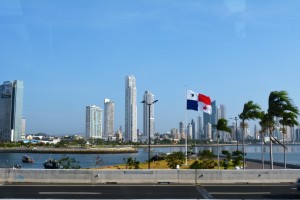
More than 500 years after Vasco Nunez de Balboa discovered the Pacific, Panama City sits proud over the sea.
Much of the Panama City waterfront, where dozens of high-rise towers have been erected, is actually reclaimed bay. A decade ago it was all ocean.
- There is a large foreign influence in the country, particularly Canadians and Americans. The government encourages foreign investment for retirees and corporations by deferring property tax for 20 years. The government also offers a selective 10 percent discount for foreigners on such things as airline rates and food. The many casinos, however, may try to reclaim some of that.
- The primary airport is Tocumen in Panama City. But there is another airport just finished along the west coast, Scarlett Martinez International Airport in Rio Hato.
Historic highlights:
-
- Panama City, founded in 1519, is the oldest continuously occupied European settlement on the Pacific coast. Some buildings and remnants of Panama La Viega, the first city, are still there.
-
- After Balboa and all the Spanish explorers and exploiters came through, English pirate Henry Morgan – later famous for namesake rum – sacked and burned Panama City in 1671. Two years later, a better fortified city rose again on the other side of the bay. That part of town, Casio Antiguo or the Historic District, is a UNESCO heritage site and a magnet for tourists.
-
The Antiguo has seen bull fights, in the French Plaza (now called Tomas Herrera Plaza), more explorers and pirates such as Sir Francis Drake and and Admiral Sir Edward Vernon along with American gangsters in the early 20th Century.
- The Antiguo is a mix of Spanish and French style architecture.
- The white Presidential Palace started in the late 17th Century, is located here, overlooking the bay.
-
The government and private companies are restoring many of the buildings. Beginning this year, the area will be closed to car traffic to allow tourists an unfettered attempt in bargaining for Panama hats.
- Panamanian strongman Omar Torrijos, who took over in coup in 1968, was a popular figure among the people but a thorn for U.S. officials. He forced the U.S. to sign the Torrijos-Carter agreement in 1977 that eventually led to Panama taking control of the Canal. He died in 1981 in a mysterious plane crash.
- Manuel Noriega rose through the military to take over leadership of the country in 1983. He was a puppet for the CIA but became heavily involved in drug trafficking. In 1989, he was captured by a U.S. invasion in Panama. He was later tried in Miami and was convicted of various charges by U.S. and French authorities. He was released in 2011 and lives in Panama.





